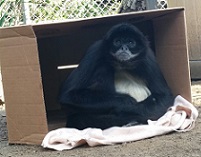Black-handed Spider Monkey
Ateles geoffroyi
- Habitat: Tropical rainforests and deciduous forests
- Range: Mexico, Central America, Bolivia
- Natural Diet: Primarily fruit, seeds, nuts, and vegetation
- Status in the Wild: THREATENED
Fun facts
- Black-handed spider monkeys have prehensile tails, which they use to wrap around tree branches to prevent them from falling
- The ends of their tails do not have hair which allows them to use their tails to hold branches and food
- Their shoulders are very flexible, which allows them to move through trees with ease
- They have long arms, legs, and tails and they use all these to swing from tree to tree
- In the wild, they live in large social groups that may have 20 to 40 individuals
Conservation Threats
The major threats are
-
Habitat loss due to human encroachment
-
Illegal trapping and hunting, and pet trafficking

.gif)